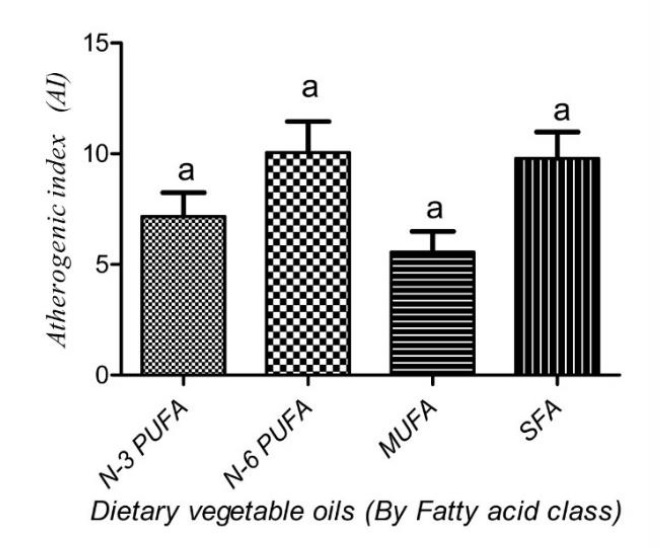Implication of total replacement of fish oil with vegetable oils on nutritional and lipid profiles of fish
DOI:
https://doi.org/10.22219/ijota.v4i1.12378Keywords:
Thrombogenic index, atherogenic index, polyene index, nutritional quality, FishAbstract
In this study, the effects of using vegetable oils solely in finfish feed on nutritional status as well as lipid damage were evaluated. Polyene index (PI), atherogenic index (AI) as well as hypocholesterolemic and hypercholesterolemic fatty acids were assessed. Also, n-3/n-6 and n-6/n-3 ratios were assessed. In all, 32 articles were used for this study after carefully assessing them. Eighteen (18) articles had studied Freshwater species (FWF) whiles fourteen (14) had studied Marine species (MF). TI, n-3/n-6, and n-6/n-3 were significantly higher in fish-fed saturated fatty acids (SFA), n-3, and n-6 dominant vegetables. We document that using vegetable oils without supplementing fish diets with fish oil does not compromise the nutritional status as well as lipid damage. This work provides important information about the effect of using 100% vegetable oils in fish with respect to the nutritional composition of the final product.
Downloads
References
Aminikhoei, Z., Choi, J., Lee, S. M. (2013). Effects of different dietary lipid sources on growth performance, fatty acid composition, and antioxidant enzyme activity of juvenile Rockfish, Sebastes schlegeli. Journal of World Aquaculture Society, 44(5): 716-725.
Apraku, A., Liping, L., Xiangjun, L., Emmanuel, J. R., & Christian, L. A. (2017). Evaluation of blended virgin coconut oil and fish oil on growth performance and resistance to Streptococcus iniae challenge of Nile tilapia (Oreochromis niloticus). Egyp. Jour. Bas. App. Sci. 4(3): 175–184.
Ayisi, C. L. & Zhao, J. L. (2017). Fatty acid composition, lipogenic enzyme activities and mRNA expression of genes involved in the lipid metabolism of Nile Tilapia fed with Palm Oil. Turkish Journal of Fisheries and Aquatic Sciences, 17(1): 405-415.
Blasbalg, T. L., Hibbeln, J .R, Ramsden, C. E., Majchrzak, S. F., Rawlings, R. R. (2011). Changes in consumption of omega-3 and omega-3 fatty acids in the United States during the 20th century. Am J Clin Nutr. 93(5): 950-962.
Calder, P. C., & Yagoob, P. (2009). Omega-3 polyunsaturated fatty acids and human health outcome. Bio Factors, 35: 266-272.
Department of Health and Social Security. (1984). Diet and cardiovascular disease. Vol. 28. Report on health and social subjects (pp. 443–456). HMSO, London.
Fukada, H., Taniguchi, E., Morioka, K., Masumoto, T. (2017). Effects of replacing fish oil with canola oil on the growth performance, fatty acid composition and metabolic enzyme activity of juvenile yellowtail Seriola quinqueradiata (Temminck and Schlegel, 1845). Aquac Res. 00: 1–12.
Hooper, L., Thompson, R. L., Harrison, R. A., Summerbell, C. D. (2009). Risks and benefits of omega 3 fats for mortality, cardiovascular disease, and cancer: Systematic review. British Medical Journal, 332: 752-760.
Hosseini, S. V., & Kenari, A. A. (2010). Effects of alternative dietary lipid sources on growth performance and fatty acid composition of Beluga Sturgeon, Huso huso, Juveniles. Journal of World Aquaculture Society, 41(4): 471-489.
Huynh, M. D., & Kitts, D. D. (2009). Evaluating nutritional quality of pacific fish species from fatty acid signatures. Food Chemistry, 114: 912–918.
Kinsella, J. E., Broughton, K. S., & Whelan, J. W. (1990) Dietary unsaturated fatty acids: interactions and possible needs in relation to eicosanoid synthesis. The Journal of Nutritional Biochemistry, 1(3): 123–141.
Lubis, L., Buckle, K. A. (1990). Rancidity and lipid oxidation of dried-salted sardines. International Journal of Food Science & Technology, 25: 295–303.
Morais, S., Edvardsen, R. B., Tocher, D. R., Bell, J. G. (2012). Transcriptomic analyses of intestinal gene expression of juvenile Atlantic cod (Gadus morhua) fed diets with Camelina oil as replacement for fish oil. Comparative Biochemistry and Physiology Part B: Biochemistry and Molecular Biology 161(3): 283-293.
Ozogul, Y., & Ozogul, F. (2013). Fatty acid profiles of commercially important fish species from the Mediterranean, Aegean and Black Seas. Food Chemistry, 100: 1634–1638.
Santos-Silva, J., Bessa, R. J. B., Santos-Silva, F. (2002). Effect of genotype, feeding system and slaughter weight on the quality of light lambs. II. Fatty acid composition of meat. Livestock Production Science, 77: 187–194.
Turchini, G. M., Ng, W. K., & Tocher, D. R. (2010). Fish oil replacement and alternative lipid sources in aquaculture feeds. CRC Press, Taylor and Francis Group, Boca Raton, FL, USA. 551 pp.
Turan, H., Sonmez, G., Kaya, K. (2007). Fatty acid profile and proximate composition of the Thornback ray (Raja clavata, L. 1758) from the Sinop coast in the Black sea. Journal of Fisheries Sciences, 1(2): 97–103.
Ulbricht, T. L., & Southgate, D. A. T. (1991). Coronary heart disease: seven dietary factors. Lancet 338: 985–992.

Downloads
Published
How to Cite
Issue
Section
License
Copyright (c) 2021 CHRISTIAN LARBI AYISI

This work is licensed under a Creative Commons Attribution-ShareAlike 4.0 International License.
IJOTA (Indonesian Journal of Tropical Aquatic) allows readers to read, download, copy, distribute, print, search, or link to its articles' full texts and allows readers to use them for any other lawful purpose. The journal allows the author(s) to hold the copyright without restrictions. Finally, the journal allows the author(s) to retain publishing rights without restrictions
- Authors are allowed to archive their submitted article in an open access repository
- Authors are allowed to archive the final published article in an open access repository with an acknowledgment of its initial publication in this journal

